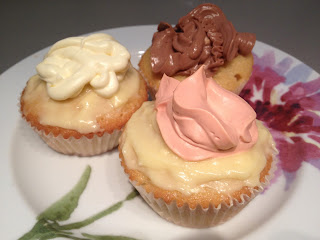Shop bought profiteroles tend to have a slightly crispy and dry pastry shell, but home baked ones are a little lighter and fluffy inside and should have an almost melt in your mouth texture. It contains no raising reagent, but instead it is extremely wet, so the steam trapped inside the pastry will make it expand. Also the butter should help to make the pastry rise just like a puff pastry.
Ingredients (makes about 30 large buns)
- 200ml cold water
- 85g unsalted butter
- 5g caster sugar
- pinch of salt
- 115g sifted plain flour
- 3 medium eggs
- 70g milk chocolate
- 100ml double cream
- 30g dark chocolate
- Pre-heat oven to 200 degrees, this is VERY important, the temperature must be high enough when the pastry goes in
- Mix water, sugar and butter together in a saucepan and melt the butter over medium low heat, stir occasionally
- Once butter has completely melted and the water is boiling, give the mix a good stir and add a pinch of salt and stir again
- Switch up heat to medium and add the sifted flour and mix it into the water. The flour should soak up the liquid quite quickly, keep stirring until the batter has become a thick paste/dough
- Remove the paste from heat and let it cool down for about 30 minutes at room temperature
- Beat the eggs and add a quarter to the batter and fold it in until it is all mixed, repeat the process until the batter is shiny and just drops off from the mixing spoon (N.B. You may not need all the eggs, in fact, it is likely you won't need all the eggs)
- Pipe the batter onto a sheet of baking parchment, I used a 2p coin as reference size
- Use a wet finger to press down the peak on the choux bun to give a flat surface and prevent the peak from getting burnt
- Bake for 25-30 minutes, the choux bun should have risen and turned slightly golden brown
- Remove from the oven and use a thin skewer to make a hole at the bottom of the choux bun to allow the steam to escape
- Put the buns back in the oven for another 5 minutes to dry off the inside
- Leave at room temperature to cool
- Melt the milk chocolate over simmering water
- Whip the cream until stiff and fold the melted milk chocolate into it to make the chocolate cream, use a piping bag with thin nodule to pipe the cream into the choux buns, make sure the buns are properly filled
- If you don't have a piping bag or nodules, slice choux bun in half and fill it this way
- Melt the dark chocolate and pipe stripes of the chocolate over the profiteroles to finish








